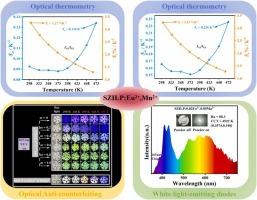Sr8ZnIn(1-m)Lum(PO4)7:Eu2+/Mn2+通过热稳定性调节、光谱调谐和共振能量转移的多种应用
IF 6.3
2区 材料科学
Q2 CHEMISTRY, PHYSICAL
引用次数: 0
摘要
本研究采用高温固相法构建了一系列β-Ca3(PO4)2型Sr8ZnIn(1-m)Lum(PO4)7:xEu2+, yMn2+ (m = 0 - 1.0)荧光粉。通过改变In/Lu的比例,可以实现荧光粉发射光谱的热稳定性和可控调谐。通过掺杂Mn2+,制备了Sr8ZnIn0.6Lu0.4(PO4) 7:02 Eu2+, 0.05Mn2+单相白色荧光粉,促进了Eu2+在各个阳离子位置的重排,并产生了从蓝绿色到橙红色的可定制发射颜色。最后,利用其优越的热稳定性,利用FIR方法构建了光学温度传感器。典型样品的最大相对灵敏度Sr和绝对灵敏度Sa分别达到3.27% K-1和0.226 K-1。在600 mA的工作电流下,基于Sr8ZnIn0.6Lu0.4(PO4) 7:02 eu2 +, 0.05Mn2+荧光粉的白光二极管产生了高质量的暖白光,具有良好的显色指数(88.3)和合适的相关色温(4522 K)。同时,利用它制备了一系列具有温度依赖特征的雪花图案。从动态颜色变化可以看出,材料在不同温度下都能保留信息,从而实现动态防伪。这些发现表明,多种用途的荧光粉系列是可能的。本文章由计算机程序翻译,如有差异,请以英文原文为准。

Multiple applications of Sr8ZnIn(1-m)Lum(PO4)7:Eu2+/Mn2+ through thermal stability adjustment, spectral tuning, and resonance energy transfer
The high-temperature solid-phase method was used in this research to construct a series of β-Ca3(PO4)2-type Sr8ZnIn(1-m)Lum(PO4)7:xEu2+, yMn2+ (m = 0 – 1.0) phosphors. By varying the ratio of In/Lu, it was possible to achieve thermal stability and controlled tuning of the phosphor emission spectrum. The single-phase white phosphor Sr8ZnIn0.6Lu0.4(PO4)7:0.02Eu2+, 0.05Mn2+ was produced by the doping of Mn2+, which encouraged the Eu2+ at various cation sites for rearrangement and produced customizable emission colors ranging from blue-green to orange-red. Finally, using its superior thermal stability, the FIR approach was used to construct an optical temperature sensor. The maximum relative sensitivity (Sr) and absolute sensitivity (Sa) of a typical sample reached 3.27 % K−1 and 0.226 K−1, respectively. At an operating current of 600 mA, the white light-emitting diodes based on Sr8ZnIn0.6Lu0.4(PO4)7:0.02Eu2+, 0.05Mn2+ phosphors produced high-quality warm-white light with an excellent color rendering index (88.3) and an appropriate correlation color temperature (4522 K). Meanwhile, a series of snowflake patterns with temperature-dependent characteristics were prepared using it. From the dynamic color change, it can be seen that the material can retain information at different temperatures, thus realizing dynamic anti-counterfeiting. These findings demonstrate that a variety of uses for this phosphor series are possible.
求助全文
通过发布文献求助,成功后即可免费获取论文全文。
去求助
来源期刊

Journal of Alloys and Compounds
工程技术-材料科学:综合
CiteScore
11.10
自引率
14.50%
发文量
5146
审稿时长
67 days
期刊介绍:
The Journal of Alloys and Compounds is intended to serve as an international medium for the publication of work on solid materials comprising compounds as well as alloys. Its great strength lies in the diversity of discipline which it encompasses, drawing together results from materials science, solid-state chemistry and physics.
 求助内容:
求助内容: 应助结果提醒方式:
应助结果提醒方式:


